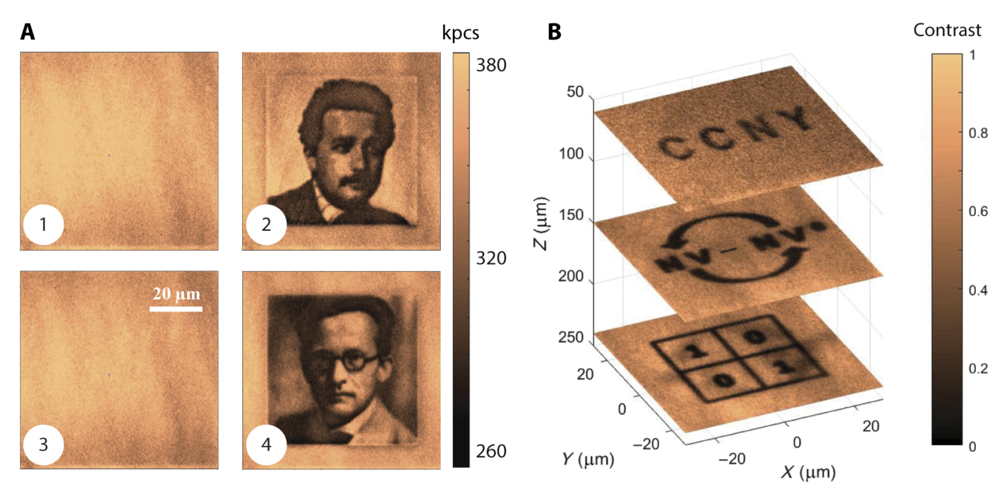R&D: Long-Term Data Storage in Diamond
3D information storage, form of stacked two-dimensional images
This is a Press Release edited by StorageNewsletter.com on November 2, 2016 at 2:30 pmScience Advances has published an article written by Siddharth Dhomkar, Department of Physics, City University of New York (CUNY) – City College of New York, New York, NY 10031, USA, Jacob Henshaw, CUNY – Graduate Center, New York, NY 10016, USA., and Department of Physics, City University of New York (CUNY) – City College of New York, New York, NY 10031, USA, Harishankar Jayakumar, Department of Physics, City University of New York (CUNY) – City College of New York, New York, NY 10031, USA, and Carlos A. Meriles, Department of Physics, City University of New York (CUNY) – City College of New York, New York, NY 10031, USA, and CUNY – Graduate Center, New York, NY 10016, USA.
Diamond as a 3D read/write memory. (A) Starting from a blank ensemble of NV− centers (1), information can be written (2), erased (3), and rewritten (4). In (1) and (3), a green laser scan (1 mW at 1 ms per pixel) was used to reset the target plane to a bright state. In (2) and (4), images were imprinted via a red laser scan with a variable exposure time per pixel (from 0 to 50 ms). Note the gray scale in the resulting images corresponding to multivalued (as opposed to binary) encoding. The samescale bar applies to all four images. (B) Information can be stored and accessed in three dimensions, as demonstrated for the case of a three-level stack.Observations over a period of aweek show no noticeable change in these patterns for a sample kept in the dark. In (A) and (B), readout is carried out via a red laser scan (200 mWat 1 ms per pixel). The image size is 150 × 150 pixels in all cases.
Abstract : “The negatively charged nitrogen vacancy (NV−) center in diamond is the focus of widespread attention for applications ranging from quantum information processing to nanoscale metrology. Although most work so far has focused on the NV− optical and spin properties, control of the charge state promises complementary opportunities. One intriguing possibility is the long-term storage of information, a notion we hereby introduce using NV-rich, type 1b diamond. As a proof of principle, we use multicolor optical microscopy to read, write, and reset arbitrary data sets with two dimensional (2D) binary bit density comparable to present digital-video-disk (DVD) technology. Leveraging on the singular dynamics of NV− ionization, we encode information on different planes of the diamond crystal with no crosstalk, hence extending the storage capacity to three dimensions. Furthermore, we correlate the center’s charge state and the nuclear spin polarization of the nitrogen host and show that the latter is robust to a cycle of NV−ionization and recharge. In combination with super-resolution microscopy techniques, these observations provide a route toward sub-diffraction NV charge control, a regime where the storage capacity could exceed present technologies.“













 Subscribe to our free daily newsletter
Subscribe to our free daily newsletter
